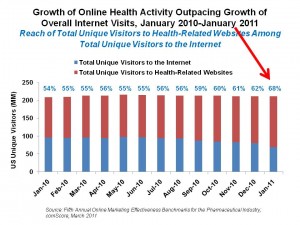 Unique visits to online health sites continue to grow as a proportion of total unique visitors to the Internet, based on comScore’s research of web activity from January 2010 to January 2011. comScore published its Fifth Annual Online Marketing Effectiveness Benchmarks for the Pharmaceutical Industry in March 2011 based on a one million person U.S. panel coupled with 77 studies into specific pharmaceutical cases.
Unique visits to online health sites continue to grow as a proportion of total unique visitors to the Internet, based on comScore’s research of web activity from January 2010 to January 2011. comScore published its Fifth Annual Online Marketing Effectiveness Benchmarks for the Pharmaceutical Industry in March 2011 based on a one million person U.S. panel coupled with 77 studies into specific pharmaceutical cases.
The growth in people using online health resources is an opportunity for health marketers — in this case, pharmaceutical drug marketers — to reach potential patients and develop more effective education campaigns that are unbranded (to provide information and condition management support) as well as expand drug brand awareness that would prompt a patient to ask about a specific medication from their physician. comScore’s research found that:
- For prospects of a prescription drug, banner ad exposure is useful in creating general brand awareness
- Banner ads coupled with rich media and more interaction builds even more brand awareness, driving more prospects to branded websites
- Once prospects and patients interact with a branded website, more people develop favorable perceptions of the brand
- Ultimately, website visitation ‘lifts’ new patient prescription starts for both prospects and patients, which drive greater ROI for the marketing campaign.
Perhaps most importantly, visits to branded Rx websites drove patients’ adherence to medications — that is, increasing refills over time.
Thus, ads alone don’t drive adherence: deeper engagement with websites, which describe side effects as well as instructions for taking the medication and scientific discussions about the drug, yield better results for both patients (in terms of adherence and condition support) and drug marketers (in terms of ROI on marketing dollars invested).
comScore worked with Evolution Road on this study, evaluating prescription drug brand awareness, brand favorability, and offline prescription activity (conversion and adherence) which was used to calculate incremental revenue generated through the brand’s online marketing campaign.
Health Populi’s Hot Points: comScore’s study shows promise for one of the Holy Grails in health — medication adherence. Patients’ lack of adherence to prescribed drug regimens for chronic condition costs the U.S. health system $290 billion annually, according to the New England Healthcare Institute‘s 2009 landmark study, Thinking Outside the Pillbox, which found that one-third to one-half of patients do not take their medications as prescribed by their physicians.
NEHI and others identify many innovations which, in combination, can address the challenge of Rx adherence:
- Developing health care teams to support the patient, which go beyond physicians to include nurses, care managers, pharmacists and other clinicians designed around key patient touchpoints
- Providing patient engagement and disease education
- Reforming reimbursement to reward positive outcomes
- Use information technologies including electronic health records, ePrescribing, and clinical decision support for prescribing physicians and pharmacists.
I would add to these remote health monitoring and patient-driven mobile phone apps that help support people on a 24×7 basis.
The role of pharmaceutical and life science companies across all of these strategies is to provide the clearest, most transparent and patient-centered information and tools that support patients — that underutilized stakeholder in the health ecosystem — in enabling them to take better care of themselves. Developing websites that do that will move the needle on medication adherence and provide ROI for the industry, patients and the larger health ecosystem.




 I am so grateful to Tom Lawry for asking me to pen the foreword for his book, Health Care Nation,
I am so grateful to Tom Lawry for asking me to pen the foreword for his book, Health Care Nation,  I love sharing perspectives on what's shaping the future of health care, and appreciate the opportunity to be collaborating once again with Duke Corporate Education and a global client on 6th May. We'll be addressing some key pillars to consider in scenario planning such as growing consumerism in health care, technology (from AI to telehealth), climate change, and trust -- the key enabler for health engagement or dis-engagement and mis-information. I'm grateful to be affiliated with the corporate education provider
I love sharing perspectives on what's shaping the future of health care, and appreciate the opportunity to be collaborating once again with Duke Corporate Education and a global client on 6th May. We'll be addressing some key pillars to consider in scenario planning such as growing consumerism in health care, technology (from AI to telehealth), climate change, and trust -- the key enabler for health engagement or dis-engagement and mis-information. I'm grateful to be affiliated with the corporate education provider  Thank you FeedSpot for
Thank you FeedSpot for